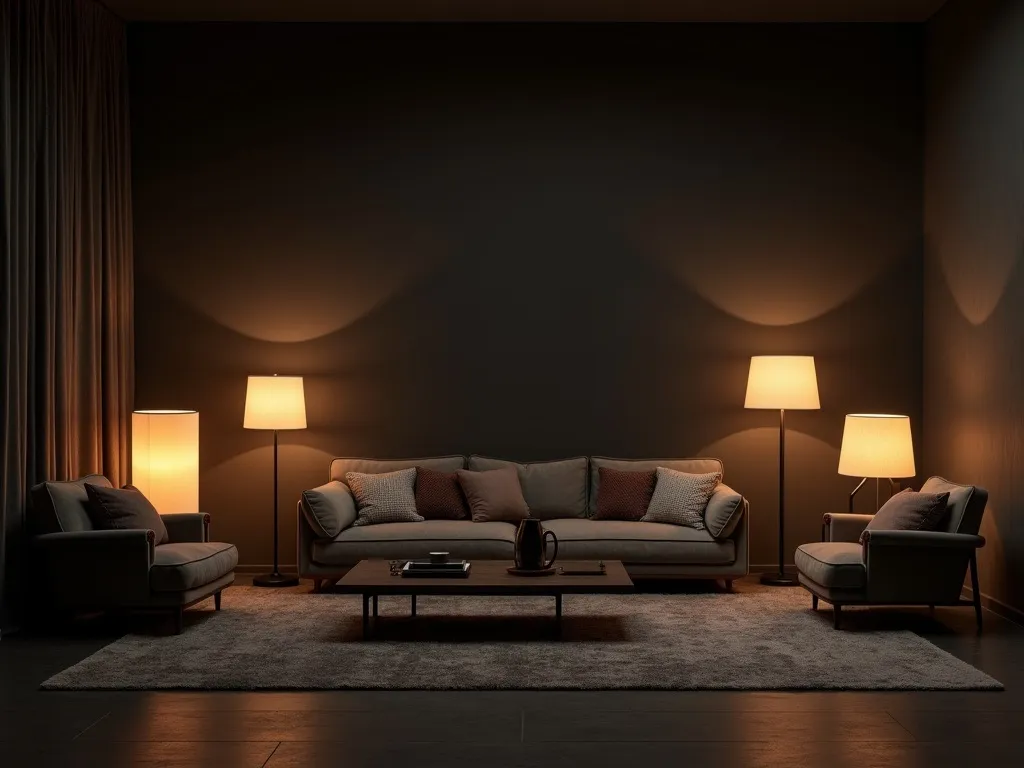Lampshades may seem like a minor detail, but they can transform the look and feel of any room. Discover the secrets to mastering this often-overlooked element of interior design.
The Transformative Power of Lampshades
In the world of interior design, lampshades are often overlooked as mere functional accessories. However, these unassuming pieces hold the power to elevate a space from drab to dazzling. With the right lampshade, a simple lamp can become a statement piece, casting a warm, inviting glow that envelops a room in ambiance. As the trend of ‘lampscaping’ – using multiple lamps to layer light throughout a space – continues to gain traction, selecting the perfect lampshade has become an essential skill for any design enthusiast.

Set beside a cozy armchair, this traditional-style ceramic lamp with a beige textured shade adds layered lighting and charm to a transitional living space. The intimate glow and earthy palette embody the principles of mood-enhancing lampscaping. Colors: warm beige, soft white, and oak brown.
Mastering the Art of Shade Selection
When it comes to choosing a lampshade, size, shape, and material are the key considerations. Traditionally, a lampshade should be roughly two-fifths of the total height of the full lamp, including the shade itself. However, retro styles often play with scale, allowing for oversized or unusually shaped shades that make a bold statement. Width-wise, the shade should match the height of the base and cover the bulb socket and any hardware, creating a seamless silhouette.

A single ceramic lamp with a bulbous, glossy cream base and soft beige shade emits a gentle glow, showcasing how lamp form and light warmth contribute to serene space styling. Perfectly suited for understated yet impactful lampscaping. Dominant tones: cream, taupe, and honeyed light.
Unveiling the Secrets of Shade Shapes
Lampshades come in a variety of shapes, each setting a distinct tone for the space. Drum shades, with their cylindrical form, are versatile and suitable for both contemporary and midcentury styles. Empire, coolie, and tapered shades exude timeless elegance, best paired with chunkier, rounder bases. Bell shades bring a romantic and soft touch to traditional spaces, while square and rectangular shades lend structure and sharpness. Oval shades are ideal for lamps with distinct front-and-back silhouettes, saving valuable space. And let’s not forget the pleated shade, a staple in traditional design, adding a decorated feel to any room.

A curated array of white lampshades in assorted classic and contemporary shapes is displayed against a soft neutral backdrop. This setup highlights the transformative power of shade style in tailoring light output and aesthetic tone.
Illuminating Materials: Crafting the Perfect Glow
The material of the lampshade plays a crucial role in the quality and style of the light it casts. Paper shades, with their minimalist aesthetic, are often found in Scandinavian and Japandi-inspired interiors, creating a clean and airy ambiance. Fabric shades, such as linen, cotton, or silk, are the most versatile. Linen and cotton diffuse light beautifully, creating a soft and inviting glow, while silk casts a luxurious, almost ethereal radiance, perfect for bedrooms or formal living areas. Metal shades, on the other hand, cast directional light, making them ideal for task lighting, but be warned – they can heat up quickly. For those seeking unexpected texture and a coastal feel, rattan shades are a unique and eye-catching choice.

Three table lamps with minimalist silhouettes and neutral linen shades offer a balanced composition of modern design and warm illumination. Each lamp varies subtly in base shape—cylindrical and gourd-like—illustrating the layering possibilities in lampscaping. Palette: brass, beige, and soft white.
Shade Hues: Elevating Your Space’s Ambiance
When it comes to color and pattern, neutral shades like white, beige, or soft gray complement almost any decor without drawing too much attention. However, for those seeking to make a bold statement, patterned or brightly colored shades can instantly energize a room. Matching the shade fabric to drapery, pillows, or wallpaper creates a cohesive design feature that ties the space together. And for those seeking a moody, intimate ambiance, dark shades provide a sultry, sexy glow perfect for cozy nooks or elegant bedrooms. With the right combination of shape, material, and hue, a lampshade can transform a room from ordinary to extraordinary, casting a warm, inviting glow that elevates the entire space.

A sleek black bedside lamp casts a warm, ambient glow against a rich terracotta wall, creating a cocoon of comfort next to a neatly made bed. This contemporary lampscape exemplifies how a single, well-placed lamp can anchor a room’s mood. Dominant tones: amber, charcoal, and ivory.



